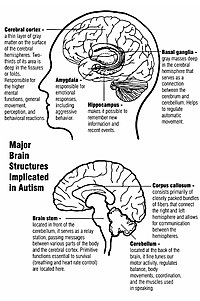
Photo from wikipedia
Exome sequencing has recently identified mutations in the gene TANGO2 (transport and Golgi organization 2) as a cause of developmental delay associated with recurrent crises involving rhabdomyolysis, cardiac arrhythmias, and… Click to show full abstract
Exome sequencing has recently identified mutations in the gene TANGO2 (transport and Golgi organization 2) as a cause of developmental delay associated with recurrent crises involving rhabdomyolysis, cardiac arrhythmias, and metabolic derangements. The disease is not well understood, in part as the cellular function and subcellular localization of the TANGO2 protein remain unknown. Furthermore, the clinical syndrome with its heterogeneity of symptoms, signs, and laboratory findings is still being defined. Here, we describe 11 new cases of TANGO2‐related disease, confirming and further expanding the previously described clinical phenotype. Patients were homozygous or compound heterozygous for previously described exonic deletions or new frameshift, splice site, and missense mutations. All patients showed developmental delay with ataxia, dysarthria, intellectual disability, or signs of spastic diplegia. Of importance, we identify two subjects (aged 12 and 17 years) who have never experienced any overt episode of the catabolism‐induced metabolic crises typical for the disease. Mitochondrial complex II activity was mildly reduced in patients investigated in association with crises but normal in other patients. In one deceased patient, post‐mortem autopsy revealed heterotopic neurons in the cerebral white matter, indicating a possible role for TANGO2 in neuronal migration. Furthermore, we have addressed the subcellular localization of several alternative isoforms of TANGO2, none of which were mitochondrial but instead appeared to have a primarily cytoplasmic localization. Previously described aberrations in Golgi morphology were not observed in cultured skin fibroblasts.
Journal Title: Journal of Inherited Metabolic Disease
Year Published: 2019
Link to full text (if available)
Share on Social Media: Sign Up to like & get
recommendations!